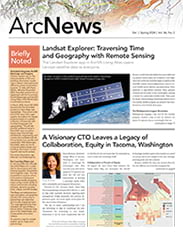Big-box retail executives, nonprofit employees, and city planners in the United States have something in common—they all use data from the US Census Bureau’s American Community Survey (ACS) to examine community characteristics. For example, stakeholders at major retailers determine new store locations and product promotion strategies by analyzing the survey’s demographic data. Grant writers identify underserved communities and use that information to apply for funding. City planners decide where to develop infrastructure and resources such as roads and fire stations based on area populations, contributing to local job growth.
The newest ACS five-year estimates, for 2018–2022, are now available in ArcGIS Living Atlas of the World. Integrating this data allows GIS professionals to explore, map, analyze, and download data at state, county, and tract levels. With these free, readily accessible, and easily downloadable layers, users can save time that would otherwise be spent processing data.

Since 2018, the ArcGIS Living Atlas policy mapping team has provided the GIS community with a comprehensive set of layers. Now, any maps or applications utilizing these layers will automatically display this up-to-date data.
Accessing the Latest ACS Data
ArcGIS Living Atlas provides a wide range of ACS layers covering various topics, such as population, income, education, health insurance, language, and race/ethnicity. These layers provide data for states, counties, and census tracts. With more than 100 layers available, users can analyze, map, and chart this information.
Each layer displays subjects on a map, accompanied by informative pop-ups that reveal important patterns. Users can also create customized web maps and apps that tell stories about topics such as population or housing.
Sourced directly from the US Census Bureau API, the ACS layers provide many benefits to users, including the following:
- Rigorous quality assurance checks ensure accuracy by comparing every value in every layer to the source.
- Source table names are documented for easy reference.
- The original census field names are used throughout, maintaining consistency.
- Boundaries are trimmed along coastlines, lakes, and major rivers to create visually appealing maps of census data.
- Additional attributes, such as percentages and related margins of error, are already calculated for convenience.
- Each field is fully documented with a human-readable field alias and a detailed field description, eliminating the need to search for metadata documents.
- Layers always reflect the latest Topologically Integrated Geographic Encoding and Referencing (TIGER) boundaries that correspond to the most recent ACS figures provided by the US Census.

